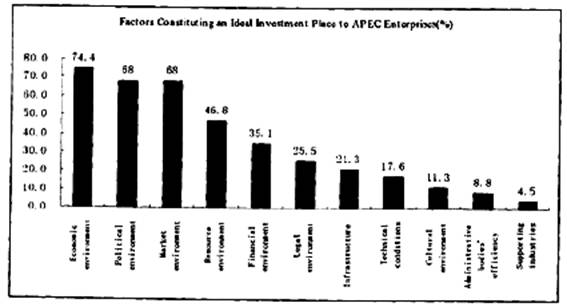Survey on Operating Environment for APEC Enterprises in China
Information Center China Entrepreneurs Survey System
From March to June last year, the State Economic and Trade Commission organized a questionnaire survey on the operating environment for the small and medium-sized enterprises invested in China by APEC members (hereinafter referred to as the APEC enterprises). The survey was actually undertaken by the China Entrepreneurs Survey System of the Development Research Center of the State Council.
Sampling units were proportional allocated to the regions and industries according to the size of the strata, with all of the APEC enterprises making up the population. A total of 16,500 copies of questionnaire were mailed and a total of 4,573 valid copies were received.
According to the received copies, the industrial distribution was respectively 2.2% for the primary industry, 85.5% for the secondary industry and 12.3% for the tertiary industry. In terms of the nature of the enterprises, the joint-venture, cooperative and solely-owned enterprises invested by people from Hong Kong, Macao and Taiwan respectively accounted for 28.2%, 3.7% and 11.5%. The Chinese foreign joint-venture and cooperative enterprises respectively accounted for 39.8% and 6.9% and the solely foreign-owned enterprises accounted for 9.9%. In terms of the source of investment, China's Hong Kong, Japan, China's Taiwan, the United States, the Republic of Korea and Singapore respectively accounted for 44.6%, 15.0%, 12.3%, 8.9%, 4.7% and 3.2%. Other APEC countries accounted for 11.2%.
The survey indicated that the managers of most APEC enterprises believed that China was the most attractive place in the Asia-Pacific region for investors, that China's social and political stability and its excellent macroeconomic conditions constitute the main guarantee for successful investment in China, that they were fully confident their investment in China would continue to grow and be profitable. They also hoped that China would further improve the investment environment by intensifying infrastructure construction, raising the efficiency of government work, establishing and improving the social security system and social service system, strengthening the legal system and regularizing the market behaviors of the enterprises.
1. Overall assessment of the operating environment: The APEC enterprises ranked the level of attractiveness of China's operating environment as the highest in the Asia-Pacific region.
1. Ideal place for investment
The survey indicated that 87.0% of the surveyed APEC enterprises listed China as one of the most attractive countries for investment among the 18 APEC members. It was followed by China's Hong Kong, Singapore, the United States, Canada and Australia. 95.3% of the surveyed APEC enterprises believed that there was still room for China to attract more foreign capital. Specifically, 43.0% of the those enterprises believed their existing scale of investment was proper, 52.3% believed the scale was smaller than desired and only 4.7% believed the scale was larger than desired. The survey showed that 95.2% of the surveyed APEC enterprises were fully confident that their investment in China will continue to grow and be profitable. Specifically, 34.3% of them were very confident and 61.0% of them were fairly confident. Only 4.7% had comparatively little confidence.
Because of their confidence in their investment in China, most APEC enterprises had long-term development plans in China. The survey indicated that 73.0% of them had operating plans for more than five years, of which 70.5% had operating plans for more than 10 years.
2. Remarkable investment performance
The survey indicated that the overall operating performance of 63.1% of the APEC enterprises improved in the past two years and only 15.1% of them saw their operating performance worsening. Specifically, 53.5% of the APEC enterprises reported increase in their tangible assets and 48.5% reported increase in their intangible assets. During the same period, only 7.0% and 6.4% of the surveyed enterprises reported falls in their tangible and intangible assets. In terms of the sales of their leading products, 54.8% reported increase while 21.0% reported reduction. As to their market shares, 78.8% said they increased or maintained their shares, while only 21.2% reported a decline in their shares.
3. Economic and political stability provided an important guarantee for foreign capital attraction
The survey indicated that foreign investors regarded China as an ideal investment ground mainly because of the favorable economic environment and stable political climate as well as the domestic market with enormous potential. Respectively 74.4%, 68.0% and 68.0% of the surveyed enterprises were optimistic about these three factors (see the figures below).

4. Labor resources, preferential policies and domestic market are the main factors attracting foreign capital
The three most important sources of benefit listed by the surveyed APEC enterprises included abundant and cheap labor resources (57.0%), preferential policies on foreign investment (42.3%) and the Chinese market with huge potential (39.4%) (see Table 1).
Table 1. Main Sources of Benefit for APEC Enterprises
|
Factor |
Percentage (%) |
|
Utilizing labor resources Taking advantage of preferential policies Expanding local market Ensuring rapid supply to consumers Obtaining local natural resources Exporting to third countries Helping head office in forming scale economy Serving head office's goal to expand and maintain overseas market Developing science and technology |
57.0 42.3 39.4 24.3 23.2 14.6 13.7 12.8 12.3 |
II. Economic and market environment: Most APEC enterprises expressed satisfaction at China's macroeconomic conditions, while a considerable proportion of them expressed concerns over the oversupply on the major commodities market.
1. Excellent macroeconomic environment
The survey indicated that 89.4% of the surveyed enterprises were satisfied or basically satisfied with the relatively low level of inflation and 79.5% were satisfied or basically satisfied with the rate of economic growth. Other satisfactory items were in the sequence of proper foreign exchange rate policy, preferential tax policy, open economic environment and financial system (see Table 2).
Table 2. APEC Enterprises' Satisfaction at Factors of Macroeconomic Environment
|
Factor |
Satisfied |
Basically satisfied |
Less satisfied |
Overall scores |
|
Inflation rate Economic growth rate Foreign exchange control Tax system Degree of openness Financial system Level of residents' consumption Banking system Economic restructuring Structure of consumption Overall economic level Scale of market Availability of local supporting industries |
29.0 25.5 16.7 16.5 19.7 14.0 13.1 16.9 11.4 11.1 11.1 16.1 10.2 |
60.4 54.0 62.0 62.3 55.7 65.7 65.4 57.2 67.6 67.7 66.5 53.7 53.0 |
10.6 20.5 21.3 21.2 24.6 20.3 21.4 25.9 21.0 21.2 22.4 30.2 36.8 |
2.18 2.05 1.95 1.95 1.95 1.94 1.92 1.91 1.90 1.90 1.89 1.86 1.73 |
Note: Overall score = (rate of satisfaction X 3 + rate of basic satisfaction X 2 + rate of less satisfaction X 1) / 100. The score ranges between 1 and 3.
2. Improved infrastructure
The shortage of infrastructure facilities used to constrain the pace of China's economic development and also the establishment of foreign-funded enterprises in many regions. The survey indicated that 90.7%, 87.9%, 87.7% and 77.7% of the surveyed APEC enterprises expressed satisfaction or basic satisfaction over the local communications facilities, water supply, energy supply and transportation. In a relative term, the transportation is yet to be further improved. At present, the supply-demand constraints in China's main infrastructure facilities have been eased to a large extent.
3. Oversupply in commodity market
The survey indicated that more than 70% of the APEC enterprises believed. that supply had exceeded demand in China's real estate market and consumer goods market. In addition, more than 50% of the enterprises believed that oversupply also existed in the capital goods market. 45% of them also believed that the current market conditions were unfavorable or very unfavorable for the operations of these enterprises.
4. Financing channels are not smooth for foreign-funded enterprises
The survey showed that 48.3% of the APEC enterprises believed that demand exceeded supply in China's capital market. Because the financing channels are not smooth, 25.9% of the surveyed enterprises expressed dissatisfaction over China's banking system. In particular, a higher percentage of the APEC enterprises in northwestern China and some provinces in central, southwestern and southern China felt difficulties in financing (see Table 3).
Table 3. APEC Enterprises' Satisfaction at Banking System
|
Region |
Satisfied |
Basically satisfied |
Less satisfied |
Overall score |
|
Bohai Sea Rim Yangtze delta & river regions Northeast China Coastal regions in southeast China Some provinces in southwest & south China Some provinces in central China Northwest China |
21.6 15.4 17.8 17.2 13.2 13.0 11.4 |
55.0 61.8 56.2 54.3 59.6 57.8 51.9 |
23.4 22.8 26.0 28.5 27.2 29.2 36.7 |
1.982 1.926 1.918 1.887 1.860 1.838 1.747 |
|
Total |
17.0 |
57.1 |
25.9 |
1.911 |
Note: Overall score = (rate of satisfaction X 3 + rate of basic satisfaction X 2 + rate of less satisfaction X 1) / 100. The score ranges between 1 and 3.
…
If you need the full text, please leave a message on the website.














